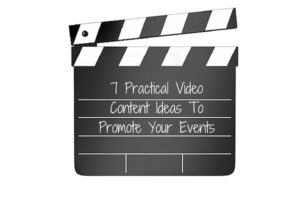 Social media has become a critical tool for the successful promotion and execution of events. Justin Guinn, market researcher at software reviews site, Software Advice, believes that this is largely due to how social today has such a great impact on event awareness and enrollment. It also helps that most event management software options on the market offer various social tools and integrations.
Social media has become a critical tool for the successful promotion and execution of events. Justin Guinn, market researcher at software reviews site, Software Advice, believes that this is largely due to how social today has such a great impact on event awareness and enrollment. It also helps that most event management software options on the market offer various social tools and integrations.
Event managers are catching on to the benefits of social strategies, which explains why 40 percent of businesses are already using social media for event marketing, and 78 percent of event organisers plan to increase their use of social media in the future. But with the rise in social media usage, many event marketers are still falling short in one critical competency: calculating the ROI of their social media strategy.
According to the 2015 Gartner report How to Measure Social Marketing ROI (available for Gartner clients), only around 56 percent of social marketing leaders are calculating an ROI for their social programs. And without proof that their social campaigns are contributing to the success of their events, social marketers will have a hard time making a case for additional resources down the line.
As such, proving an ROI on social marketing should be a priority for event management teams who market on social channels. That’s why we’re listing three tips to help you calculate the ROI of a social marketing for event planning. Follow these guidelines to build buy-in for your social strategy.
 1. Track Attendance Driven by Social Engagement Campaigns
1. Track Attendance Driven by Social Engagement Campaigns
There’s no one right answer for how to track event enrollment via social channels. As a general rule, you should be tracking the number of times a visitor lands on your website from a social networking site and also the number of those visitors who convert into customers or attendees.
The most popular tracking method for social traffic to your site is to include UTM tracking codes on your hyperlinks. UTM codes are enabled by Google Analytics and require some knowledge of that platform. Google Analytics training, which Google offers for free, is a good place to start if you’re a UTM/Analytics novice.
The UTM codes themselves are attached to the end of the hyperlinks you include in social posts, and they work as identifiers for Analytics to track various valuable metrics. They offer an invaluable snapshot of traffic driven by each post.
As Michael Stancil of PracticalEcommerce explains: “You may be wondering, ‘Why do I need to know clicks and conversions if the Facebook ad dashboard tells me this?’ That’s a valid question. But with the data provided to you in Facebook’s ad dashboard, you’re only scratching the surface. You won’t see how that traffic actually interacts on your site. And if you’re concerned about other metrics (as you should be) —such as time on site, number of pages viewed and bounce rate—you won’t be able to find them.”
Regardless of how you go about it, accurately tracking the traffic your social campaigns are driving is hugely important. Proper tracking enables you to see just how much traffic each social post is driving, as well as how much money that traffic is generating. Monitoring these various metrics will make it more clear what works and what doesn’t, and enable you to steer your social strategy in the best direction for your business.
2. Recognise the Importance of Engagement and Social Listening
Tracking social-driven traffic and tying it directly to revenue is one of the most tangible ROI calculations you can provide. But there is plenty of other value that engagement on social channels can provide.
One important metric is social listening. Engagement through social listening manifests itself in many ways, but most often takes the form of responding to concerns and complaints launched by customers at your social accounts.
According to an event marketing-focused social media article from The Bizzabo Blog, there was an 800 percent increase in social media complaints about businesses in the U.K. over one year. Likewise, the Guardian reported that one in four social media users in the U.K. used social platforms to voice complaints in the first three months of 2015 alone.
Of course, you never want customers to complain about your business, brand, products, events etc. But there is a silver lining here—recurring complaints can signal trends that need to be addressed.
Even a single complaint has value, in that it organically opens the door for you to engage the customer and respond to their complaint. And if you’re going to respond, be timely about it. The Bizzabo Blog states that 40 percent of customers who complain on social media expect a response within one hour.
Your engagement, whether it’s to offer a solution, recompense or even simply acknowledge the complaint, is a successful social touch point that contributes to the overall customer advocacy of your organisation. In fact, Bizzabo found that when a complaint is answered by a business, it leads to a 25 percent increase in customer advocacy.
 3. Leverage Social as a More Efficient Channel of Communication
3. Leverage Social as a More Efficient Channel of Communication
The third metric for calculating the ROI of social media marketing for your events is the cost savings. Social marketing is incredibly efficient when compared to more traditional marketing channels.
Take, for example, the Kissmetrics Blog’s stat that around 77 percent of event marketers are leveraging social to engage with attendees and build hype and awareness prior to events. How else would that hype have been built, if not through social channels? Emails, phone calls, print campaigns, TV and radio advertisements? These are all lofty investments in terms of additional resources, labour hours and materials involved.
 Depending on your business’s size, you could potentially operate your social campaigns and manage customer/attendee questions and complaints through those channels with one dedicated employee.
Depending on your business’s size, you could potentially operate your social campaigns and manage customer/attendee questions and complaints through those channels with one dedicated employee.
The greater operational efficiency social offers can go a long way to winning greater buy-in and approval for even more resources from those in charge. Especially if you can turn a minimal-spend social strategy into an actual profit centre for your business. Even if it’s only a percentage of your total revenue, it’s coming at virtually no cost to the business.
 Justin Guinn is a Market Researcher at Software Advice, a company that hosts research and reviews of event management and registration software comparisons, and software for small businesses and non-profits. His work has been cited in dozens of notable publications, including The New York Times, Forbes, The Huffington Post and TIME Magazine. His research explores the impacts of emerging software and technologies, and he has conducted primary research with both consumers and business owners to get a full picture of technology’s role in these markets today.
Justin Guinn is a Market Researcher at Software Advice, a company that hosts research and reviews of event management and registration software comparisons, and software for small businesses and non-profits. His work has been cited in dozens of notable publications, including The New York Times, Forbes, The Huffington Post and TIME Magazine. His research explores the impacts of emerging software and technologies, and he has conducted primary research with both consumers and business owners to get a full picture of technology’s role in these markets today.




















